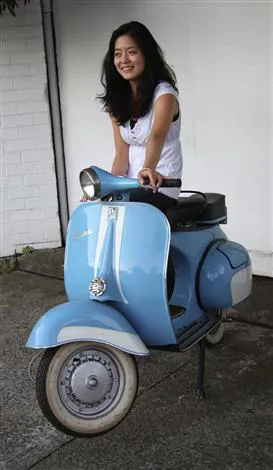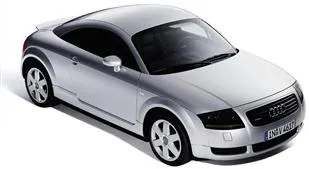1.1 Introduction
The term “design” is popularly used to refer to an object's a esthetic appearance, with specific reference to its form or outward appearance as well as its function. For example, we often refer to designer clothes, design icons, and beautiful cars, examples of which are given in Figures 1.1 and 1.2. In these examples, the products fulfill a range of requirements with regard to visual impact, i.e. something that appeals to our visual perception, and technical function, both of which are important in defining so-called “good design.”
Figure 1.1 Piaggio's Vespa, which was launched in 1946. The Vespa was an early example of monocoque construction where the skin and frame are combined as a single construction to provide appropriate rigidity and mounting for the vehicle's components and riders.
Figure 1.2 The Audi TT, which was originally launched in 1998 and is a contender for the most attractive sports car of the twentieth century. Figure courtesy of Audi.
The word “design” is used as both a noun and a verb, and it carries a wide range of context-sensitive meanings and associations. As stated by George Cox in the Cox Review (Cox, 2005), “Design is what links creativity and innovation. It shapes ideas to become practical and attractive propositions for users or customers. Design may be described as creativity deployed to a specific end.” In essence design can be considered to be the process of conceiving, developing, and realizing products, artifacts, processes, systems, services, and experiences with the aim of fulfilling identified or perceived needs or desires typically working within defined or negotiated constraints. This process may draw upon and synthesize principles, knowledge, methods skills, and tools from a broad spectrum of disciplines depending on the nature of the design initiative and activity.
The word design comes from the Latin “designare,” which means to designate or mark out. Design can be taken to mean all the processes of conception, invention, visualization, calculation, refinement, and specification of details that determine the form of a product. Design generally begins with either a need or a requirement or, alternatively, an idea. It ends with a set of drawings or computer representations and other information that enables a product to be manufactured and utilized.
Design can be regarded as “the total activity necessary to provide a product or process to meet a market need.” This definition comes from the SEED (Sharing Experience in Engineering Design) organization, which is now the DESIG (Design Education Special Interest Group of the Design Society) (see Pugh, 1990).
According to a Royal Academy of Engineering pamphlet, engineering can be defined as,
The discipline, art and profession of acquiring and applying scientific, mathematical, economic, social and practical knowledge to design and build structures, machines, devices, systems, materials and processes that safely realize solutions to the needs of society.
This definition is not attributed to a single individual, and the Accreditation Board for Engineering and Technology (ABET, 2011), the Institution of Mechanical Engineers, and the National Academy of Engineering (2004) all have similar definitions for engineering where scientific and mathematic principles are applied to design, develop, and deliver artifacts, products, and systems to realize a societal, commercial, or organization requirement or opportunity.
The terms “engineering design” and “design engineering” are often used interchangeably. The inclusion of the word engineering in both suggests that they involve the application of scientific and mathematical knowledge and principles. It may be useful to think of “engineering design” in connection with “engineering science” as the strand of engineering that is concerned with application, designing, manufacturing, and building. Design engineering suggests a process in which engineering (scientific and mathematical) approaches are applied in the realization of activities that began with a design concept or proposal. However, such distinctions remain subtle and subject to context.
1.2 The Design Process
Design processes abound and have been widely documented, with many design schools, design consultancies, and engineering corporations developing their own brand of approaches (e.g. see Clarkson and Eckert, 2005). Commonly cited methods include the educational approach CDIO (conceive, develop, implement, operate), total design, double diamond, six sigma, MDO (multiobjective design optimization), and gated reviews. Design processes can be broadly categorized as activity-based, involving generation, analysis, and evaluation, and stage-based, involving distinct phases of, for example, task clarification and conceptual design. It is also widely recognized that experienced practitioners approach design in a different manner to novice designers (e.g. see Ahmed et al., 2003).
From your own experience, you probably know that design can consist of examining a design need and working on the problem by means of sketches, models, brainstorming, calculations as necessary, development of styling as appropriate, making sure the product fits together and can be manufactured, and calculation of the costs. The process of design can be represented schematically to levels of increasing formality and complexity. Figure 1.3 represents the traditional approach associated with lone inventors. This model comprises the generation of the “bright idea,” drawings and calculations giving form or shape to the idea, judgment of the design, and reevaluation if necessary, resulting in the generation of the end product. The process of evaluation and reworking an idea is common in design and is represented in the model by the iteration arrow taking the design activity back a step so that the design can be improved. Figure 1.4 illustrates the possible results from this process for a helmet providing peripheral and reverse vision.
Figure 1.3 The traditional and familiar “inventor's” approach to design.
Figure 1.4 Panoramic helmet by Alberto Meda and Denis Santachiara. (a) The need: to be able to view behind you. (b) The idea: An optical link using fiber optics and lenses. (c) Practical sketches showing the concept. Source...




